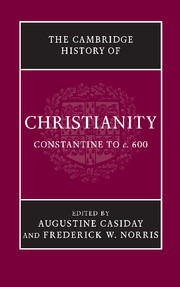Book contents
- Frontmatter
- Introduction
- Part I Christianity: Regional Developments
- Part II Christianity Contested
- 5 Religious dynamics between Christians and Jews in late antiquity (312–640)
- 6 Christianity and paganism, I: Egypt
- 7 Christianity and paganism, II: Asia Minor
- 8 Christianity and paganism, III: Italy
- 9 Christianity and paganism, IV: North Africa
- 10 The intellectual debate between Christians and pagans
- 11 Christianity and Manichaeism
- 12 Heresiology: The invention of ‘heresy’ and ‘schism’
- Part III Christian Culture and Society
- Part IV Christian Beliefs and Practices
- Index
- Map 1 The Roman empire, c. 400">
- References
9 - Christianity and paganism, IV: North Africa
from Part II - Christianity Contested
Published online by Cambridge University Press: 28 March 2008
- Frontmatter
- Introduction
- Part I Christianity: Regional Developments
- Part II Christianity Contested
- 5 Religious dynamics between Christians and Jews in late antiquity (312–640)
- 6 Christianity and paganism, I: Egypt
- 7 Christianity and paganism, II: Asia Minor
- 8 Christianity and paganism, III: Italy
- 9 Christianity and paganism, IV: North Africa
- 10 The intellectual debate between Christians and pagans
- 11 Christianity and Manichaeism
- 12 Heresiology: The invention of ‘heresy’ and ‘schism’
- Part III Christian Culture and Society
- Part IV Christian Beliefs and Practices
- Index
- Map 1 The Roman empire, c. 400">
- References
Summary
The diffusion of Christianity in North Africa was marked by complex interaction on several fronts, initially between pagans and Christians, and later within the church itself as schisms occurred. The Christianisation of North Africa resulted in a progressive acquisition of power (both religious and secular/economic) by the clergy. This chapter will synthesise the main phases of this process, paying particular attention to the role of the clergy, its transformation over the centuries and the impact of Christianisation on society and economy. Our evidence will be taken from both written and archaeological sources.
Pagan and Christian communities
The earliest Christian communities of North Africa frequently interacted with, and reacted to, local pagan traditions. Some episodes in Augustine’s life described this interaction. In general, fourth-century pagan tradition was still very lively; it provided one of Augustine’s main opponents. For instance, he mentions a strong pagan community at Liber de promissionibus et predicationibus Dei 3.38. There, Augustine writes that pagans revolted against the decision by Christian clergy to build a basilica above the temple of Caelestis in Carthage. This insurrection prompted the tribune Ursus to destroy the temple completely and build a new church on the site. On-going pagan practice is also confirmed by several mosaics of distinctly pagan iconography found in both private and public buildings. A Dionysiac scene discovered in the so-called ‘schola’ at Carthage (built probably at the beginning of the fifth century) indicates active devotees to this god. In some North African cities, theatres and amphitheatres were still pulling in big audiences, as in the Bulla Regia mentioned by Augustine.
Keywords
- Type
- Chapter
- Information
- The Cambridge History of Christianity , pp. 231 - 247Publisher: Cambridge University PressPrint publication year: 2007
References
- 1
- Cited by

